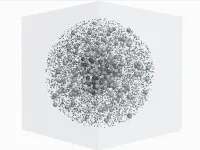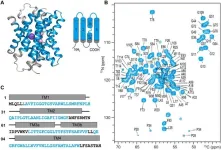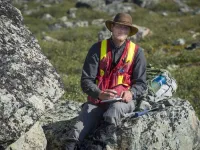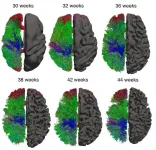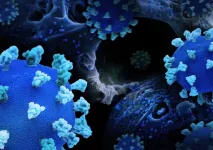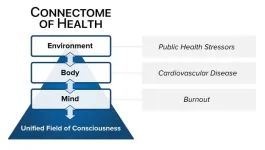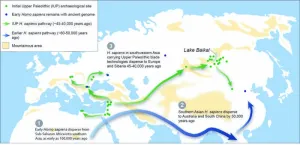(Press-News.org) MIAMI, FLORIDA (Sept. 22, 2023) – Researchers at Sylvester Comprehensive Cancer Center at the University of Miami Miller School of Medicine found an association between “social determinants of health” and outcomes and survival in patients undergoing surgery and treatment for non-small cell lung cancer.
The findings are based on a statistical scoring system the researchers developed that consolidates and analyzes several measures of socioeconomic status and related factors.
“We believe our social determinants of health scoring system is the first to provide a composite perspective on many of the nonmedical factors that affect outcomes in patients receiving treatment for non-small cell lung cancer,” said Dao Nguyen, M.D., Sylvester Thoracic Cancers Group co-leader. He said the study focused on patients with stage 2 or stage 3 NSCLC, with surgically confirmed metastasis to regional lymph nodes within the chest cavity.
Ideally, Nguyen said, patients with these cancers should receive ‘multimodal’ care – chemotherapy, immunotherapy and, in some cases, radiotherapy – and this high level of expertise and care may best be provided by specialized, comprehensive centers like Sylvester, a National Cancer Institute-designated center.
But studies have shown that better or worse outcomes result from more than just medical and surgical treatments. Socioeconomic disadvantages, for example, have been associated with lower-quality care and suboptimal outcomes. Social determinants of health, or SDH, include income, wealth, education, geographical location, access to specialized care and other nonmedical factors that influence health outcomes.
“Our analysis shows that SDH scores can identify patients who are at increased risk even if they undergo adequate initial treatment. Our research also may help point the way toward improving strategies and care for patients with lung cancer who are socioeconomically disadvantaged,” said Nguyen, a thoracic surgeon who treats and studies lung and other cancers and is the senior author of an article published online ahead of print in The Journal of Thoracic and Cardiovascular Surgery.
Nguyen and colleagues analyzed data from 11,274 patients with locally advanced NSCLC in the National Cancer Database (NCDB), a registry provided by the American College of Surgeons and the American Cancer Society. Patients with locally advanced disease make up about one-third of the NSCLC population. In the study sample, average patient age was about 68, and 57% of patients were female. Eighty-four percent of patients in the sample were non-Hispanic white, 8.8% were Black, 3.0% were Hispanic, and 3.3% were Asian.
The researchers quantified results based on the medical research term “textbook oncological outcome,” which considers several metrics and translates to the most desirable or optimal outcome for patients undergoing surgery to remove a primary cancer. These factors include complete resection, adequate lymph node removal, timely initiation of other therapies when needed, and short hospital stay. Textbook outcomes also are reflected in statistics on mortality, re-intervention, readmission, and major complications.
The Sylvester study aimed to determine the rate of achieving ideal outcomes in relation to social determinants of health scores, the association between these scores and optimal outcomes, and the association between SDH and overall survival.
The researchers focused on income, place of residence, level of education, and location of hospitals in proximity to patient residence. Other variables of interest included patient demographics, types of treatment facilities, surgical volumes at treatment facilities (representing experience and expertise), and whether patients had other medical conditions or diseases in addition to NSCLC.
“In this cohort, we found that socioeconomic status – indicated by SDH score – has an important association with both textbook outcomes and survival,” said Ahmed Alnajar, M.D., the paper’s first author. “Significant socioeconomic disadvantage was associated with a 21% decrease in textbook outcomes and a 32% decrease in overall survival when compared to a patient subgroup that was not disadvantaged. Vulnerable patient population groups living in areas with limited income, limited education, rural locations, and areas with limited access to specialized cancer care settings are at increased risk of poor outcomes and long-term mortality.”
Among highlights from the article:
In this study, patients living in rural areas had a 30% decreased likelihood of overall survival and long-term outcomes.
Having access to only community hospitals adversely affected survival.
Having surgery performed in a high-volume hospital decreased mortality risk by 31% and increased textbook outcome likelihood by 93%, compared to having surgery completed in a low-volume hospital.
Black patients were 31% less likely to achieve optimal, textbook outcomes than were white patients.
The authors say policymakers should ensure equitable access to surgery and multimodality therapy to be sure all patients receive the best care. They also say surgeons and other care providers can strategically allocate resources and target interventions to counter the effects of SDH inequities.
Authors: In addition to Nguyen and Alnajar, Karishma Kodia, M.D., and Nestor Villamizar, M.D., contributed from Sylvester and the University of Miami Miller School of Medicine. Syed Razi, M.D., contributed from Hackensack Meridian Health in Edison, New Jersey.
Funding: This work received no external funding.
Conflicts of interest: The authors declare no conflicts of interest or disclosures.
Publication: The Journal of Thoracic and Cardiovascular Surgery, “The Impact of Social Determinants of Health on Textbook Oncological Outcomes and Overall Survival in Locally Advanced Non-Small Cell Lung Cancer.”
DOI: 10.1016/j.xjon.2023.09.013
# # #
END
A research team led by Prof. WANG Junxian from the University of Science and Technology of China (USTC) of the Chinese Academy of Sciences (CAS) revealed a clumped, multi-component eclipsing absorber in a study of X-ray occultation events in the active galaxy NGC 6814. The results were published in Monthly Notices of the Royal Astronomical Society on Aug. 23.
Active galactic nuclei have strong X-ray emission originating in a compact region near the supermassive black hole, the so-called corona region. When an absorbing ...
UNIVERSITY PARK, Pa. — Macrophages are little cells vital to the immune system and could possibly inform cell-based therapies for a variety of medical conditions. However, realizing the full potential of macrophage therapies relies on being able to see what these cellular allies are doing inside our bodies, and a team of Penn State researchers may have developed a way to watch them do their thing.
In a study published in the journal Small, the Penn State researchers report a novel ultrasound imaging technique to view macrophages continuously in mammal tissue, with potential for human ...
On August 23, 2023, a research team led by SHI Chaowei from the University of Science and Technology of China (USTC) of the Chinese Academy of Sciences (CAS) published a paper titled "Fluoride permeation mechanism of the Fluc channel in liposomes revealed by solid-state NMR" in Science Advances. The team adopted the fluoride ion channel protein Fluc-Ec1 combined with deuterium substitution and 19F labeling methods, paving a new path for membrane protein nuclear magnetic resonance (NMR) research.
NMR not only provides insights into molecular structures ...
UNIVERSITY PARK, Pa. — The Earth’s crust continued a slow process of reworking for billions of years, rather than rapidly slowing its growth some 3 billion years ago, according to a Penn State-led research team. The new finding contradicts existing theories that suggest the rapid formation of tectonic plates earlier in Earth’s history, researchers said.
They published the research in Geochemical Perspectives Letters.
The work may help answer a fundamental question about our planet and could hold clues as to the formation of other planets, according to lead author ...
How similar are dinosaurs to modern birds? This question is at the heart of a new study that examined how proteins found in dinosaur feathers changed over millions of years and under extreme heat.
Previous studies suggest that dinosaur feathers contained proteins that made them less stiff than modern bird feathers. Now, researchers with University College Cork (UCC), the Stanford Synchrotron Radiation Light Source (SSRL) at the Department of Energy's SLAC National Accelerator Laboratory and other institutions have discovered that dinosaur feathers originally had a very similar protein composition to those of modern birds. That result ...
A single brain is unfathomably complex. So brain researchers, whether they’re looking at datasets built from 300,000 neurons in 81 mice or from MRIs of 1,200 young adults, are now dealing with so much information that they must also come up with new methods to comprehend it. Developing new analysis tools has become as important as using them to understand brain health and development.
A team including researchers at the University of Washington recently used new software to compare MRIs from 300 babies and discovered that myelin, a part of the brain’s so-called white matter, develops much slower after birth. The researchers published their findings Aug. ...
A clinical trial has launched to test whether early intensive immune modulation for hospitalized COVID-19 patients with relatively mild illness is beneficial. The placebo-controlled study, part of the global clinical trials consortium known as Strategies and Treatments for Respiratory Infections and Viral Emergencies (STRIVE), will enroll approximately 1,500 people at research sites around the world. It is supported by the National Institutes of Health’s National Institute of Allergy and Infectious Diseases (NIAID) in partnership with NIH’s National Center for Advancing Translational Sciences (NCATS).
Immune ...
PHILADELPHIA – A study in the Proceedings of the National Academy of Sciences (PNAS) identifies five factors that Annenberg Public Policy Center (APPC) researchers say reflect public assessments of science and are associated with public support for increasing funding of science and support for federal funding of basic research. These factors are whether science and scientists are perceived to be credible and prudent, and whether their work is perceived to be untainted by bias, self-correcting, and beneficial.
Drawing on 13 questions in APPC’s 2022 nationally representative ...
A new editorial published in the Heart and Mind journal proposes an innovative systems medicine approach to address the epidemic of clinician burnout and holistically improve clinician mental health and wellbeing (Heart and Mind: September 18, 2023. | DOI: 10.4103/hm.HM-D-23-00013, published ahead of print).
In the US and globally, clinician burnout has reached epidemic levels, with over 50% of physicians and healthcare providers reporting symptoms. Besides impairing quality of life, burnout increases risk of mental health disorders, cardiovascular disease and impaired ...
LAWRENCE — It’s an Ice Age mystery that’s been debated for decades among anthropologists: Exactly when and how did the flow of Homo sapiens in Eurasia happen? Did a cold snap or a warming spell drive early human movement from Africa into Europe and Asia?
A new study appearing in Science Advances compares Pleistocene vegetation communities around Lake Baikal in Siberia, Russia, to the oldest archeological traces of Homo sapiens in the region. The researchers use the “remarkable evidence” to tell a compelling story from 45,000-50,000 years ago with new detail: how the first humans migrated across ...

